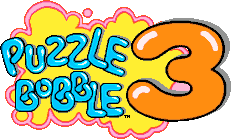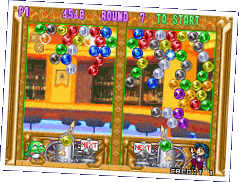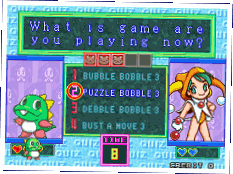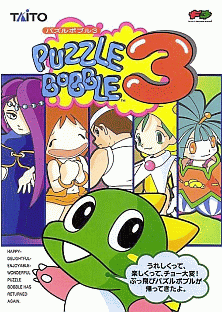
Manufacturer: ![]()
Year: 1996
  |
No rest for the two beloved Bub and Bob... After completing the quests in Bubble Bobble and Rainbow Islands (and Parasol Stars, and Bubble Memories, and...) and after the first two chapters of Puzzle Bobble, they must be back to the scene to face another challenge... The fields are the same of the previous chapter: you stay at the bottom of a well (? I guess...) and you have to pop all the bubbles attached to the ceiling of the well in order to get out of there. You throw bubbles from the bottom to make the way. Obviously it's not so easy: bubbles are made of different colours and you must throw a bubble of the same colour of two or more near bubbles on the ceiling. The colour of the bubble you throw is absolutely random. Well that's not enough... As the game is substantially a challenge against time, the ceiling sometimes bends down of a step, and if a bubble reach your level at the bottom, the game is over. Uhm... such a simple game to play and such a difficult concept to explain... I guess I need more English lessons heh! The game is substantially reduced to the shifting
of the bubble thrower pointer. You must consider the direction of the
bubbles before firing them, but with a little train you should be familiar with the
degrees of a throw. |
|
 |
  |
You can choose one of three game modes, each having three available difficulty levels. They are Puzzle, Player vs Computer and Player vs Player. The difficulty levels are training, normal and ver. 2.5 for the Puzzle mode; training, normal and hard for Player vs Computer mode, and training, normal and variety for Player vs Player mode. I think I don't need to explain the training level but... well, people at Taito's are really special to make games hard to describe. OK, I'll try to do it. Puzzle game: in normal mode you can choose a path after completing each stage, each step being marked with an alphabet letter. There are two kinds of step, one (normal) is composed by five sublevels with a normal puzzle game mode, and the other (special) is composed by a single sublevel, much harder, where you try against time. In ver 2.5 you can only choose normal steps (five sublevels) like in Puzzle Bobble 2. Player vs Computer: difficulty levels are standard here. Player vs Player: in normal mode, all the bubbles on the ceiling have been previously stuffed in a rectangular (it's easier to clear levels). In variety mode bubbles are scattered in random way. |
|
As I told it before, in puzzle game mode you play levels through the path you choose. In VS mode you play levels through various scenarios depending on your opponents. Each opponent comes out of a specific Arcade (or game) and the scenario reflects the same features as your opponent. In the Player VS Player mode, scenarios are random. In VS type game (player or computer), the screen is splitted vertically into two parts. Each time a player pops more than 3 bubbles, he throws every additional bubbles to his opponent. In addition to normal bubbles, every character passes special bubbles (e.g. rainbow bubbles) to opponent. This is very annoying, especially when you're ready to pop more than three bubbles... As you understand, the concept is really simple. Great Puzzle games are usually simple to play, but you need skill to pass levels (think about Tetris). However this videogame adds no news to Puzzle Bobble 2. There are graphic enhancements, but you know that: graphics are not the most important thing, even though it was a feature which took lots of consideration in the 90's. There are also gameplay enhancements, but nothing special. And, finally, the in-game music... Why did Taito force decide to us listenening to the same music as the first game of the saga? ...I don't understand. I guess in arcades you don't usually pay attention to the soundtrack, but this is really annoying. speaking of the sound effects, they're good but unable to make the general sound of this game better. But you know... Puzzle Bobble is a milestone and this third chapter is almost the same quality as the first two chapters. |
 
|

Ratings
PRESENTATION: 82%
Great colourful attractive mode!
GRAPHICS: 85%
As good as in the other
chapters. Little confusing
backgrounds though...
SOUND: 69%
So boring, please stop it!
ORIGINALITY: 58%
Chapter=3, innovations=0...
HOOKABILITY: 85%
...but the concept is still great!
LASTABILITY: 83%
Many chances in single and
VS computer modes save this
game from the hell of arcades.
A great sequel to a
masterpiece. Play it!
 Third
chapter of the saga. The game concept is not so new but it's still charming. The only
addition to its predecessors is the omnipresent "VS mode" offering a choice between
various characters, and a renewed stand-alone game mode. Graphics are average, what I don't
understand is sound... I know that Taito's "cartoonish" games are
legacy-oriented (do you remember Bubble Bobble or The Newzealand Story? Great
games with a really obsessive background music...) and the tunes are really repeating and
boring - even if it's a good remix of the main tune from the first chapter. I think musicians
could have thought for something more varying. Yes sound effects are good, but they just
can't give to the game a great sound.
Third
chapter of the saga. The game concept is not so new but it's still charming. The only
addition to its predecessors is the omnipresent "VS mode" offering a choice between
various characters, and a renewed stand-alone game mode. Graphics are average, what I don't
understand is sound... I know that Taito's "cartoonish" games are
legacy-oriented (do you remember Bubble Bobble or The Newzealand Story? Great
games with a really obsessive background music...) and the tunes are really repeating and
boring - even if it's a good remix of the main tune from the first chapter. I think musicians
could have thought for something more varying. Yes sound effects are good, but they just
can't give to the game a great sound.
The three game modes give the game a good lastability. I found the standalone mode the best
one - as I am a classics lover, and the ver 2.5 being a real challenge to even Puzzle
Bobble hardcore gamers. The path selector after each level gives a touch of randomization
which makes lastability grow.
The VS mode is a little bit static, even if each character has his own "secret moves"
(actually there are no secret moves, indeed each character throws the opponent different kinds
of bubbles when he pops). Finally a great sequel of the saga, but the little changes to the
original gameplay aren't worth playing: only the great concept and immediate action take this
game out the Arcade's Ade. And... Please Taito, change the melodies in further chapters
of your games...
 Once
more Taito presents a videogame with Bub and Bob as main characters, plus plenty of
new friends! Puzzle Bobble 3 keeps the same gameplay as the previous episodes (same as
also happened to the fourth chapter). The enhanced graphics and sound of the f3 PCB aren't
usually enough to renew an almost "old" videogame but that's is not true for
Puzzle Bobble 3, which is an entertaining videogame - at least for a while.
Once
more Taito presents a videogame with Bub and Bob as main characters, plus plenty of
new friends! Puzzle Bobble 3 keeps the same gameplay as the previous episodes (same as
also happened to the fourth chapter). The enhanced graphics and sound of the f3 PCB aren't
usually enough to renew an almost "old" videogame but that's is not true for
Puzzle Bobble 3, which is an entertaining videogame - at least for a while.
Introduction is very nice with colourful images, hooking characters and new levels to play.
Another funny videogame, though I prefer the previous chapters.
 Does
one really have to comment on this game? Ok, the idea is not really that original anymore.
It's the third part after all. But still developers came up with some nice new ideas and an
even more colorful graphics and nicer sounds than before. You can see that it's a good game
because I used to play it with a girlfriend of mine and she loved it. Now, if even a girl
likes to play an old classic, that oughts to mean something. And it's really great to jump
into Puzzle Bobble 3, play through the different worlds and try your wits against
even the hardest of opponents. Play the game and enjoy it, it's best with two players.
Does
one really have to comment on this game? Ok, the idea is not really that original anymore.
It's the third part after all. But still developers came up with some nice new ideas and an
even more colorful graphics and nicer sounds than before. You can see that it's a good game
because I used to play it with a girlfriend of mine and she loved it. Now, if even a girl
likes to play an old classic, that oughts to mean something. And it's really great to jump
into Puzzle Bobble 3, play through the different worlds and try your wits against
even the hardest of opponents. Play the game and enjoy it, it's best with two players.